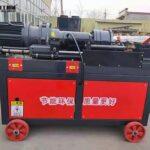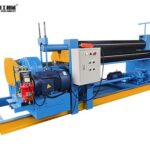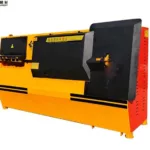Automatic thread rolling machine is a specialized industrial equipment designed to form threads on steel bars through thread roll wheels. Thread rolling deforms the workpiece’s surface, resulting in stronger, more durable threads with superior surface finish. The automation aspect refers to the machine’s ability to operate with minimal human intervention, often integrated into production lines for continuous operation. This technology has gained immense popularity due to its ability to enhance productivity, reduce waste, and maintain consistent quality. I play an important role in the construction of machines.
Features of Automatic Thread Rolling Machine
- A high-performing automatic thread rolling machine typically comes with advanced features that improve operational performance:
- Precision Control: Equipped with computerized or digital control systems that ensure uniform thread pitch, depth, and angle.
- Durable Rollers: Hardened steel rolling dies with long service life for different thread types.
Applications and Uses
- Construction: Production of rebar threaded connections and fasteners for building frameworks and infrastructure projects.
- Machinery and Equipment: Producing machine parts such as screws, rods, and fittings that demand precision and reliability.
- Automotive Industry: Manufacturing threaded components like bolts, studs, and shafts for engines and chassis.
- Consumer Goods: Threaded fasteners for household appliances, tools, and electronics.
Advantages of Automatic Thread Rolling Machine
- Superior Surface Finish: The rolling process produces smooth surfaces that require no additional finishing.
- High Efficiency: Automated operation ensures faster cycle times and consistent production.
- Accuracy And Consistency: CNC or digital controls guarantee repeatable quality even in large-scale production.
How to Choose an Automatic Thread Rolling Machine?
- Production Capacity: Match the machine’s speed and throughput with your production requirements.
- Thread Range: Ensure compatibility with the required thread sizes and standards.
- Material Type: Consider the metals you will process and whether the machine supports them.
- Automation Level: Advanced models offer CNC integration and automated feeding systems for higher efficiency.
- Durability: Look for machines made from robust materials with high-quality dies and long service life.
- After-Sales Support: Availability of spare parts, technical service, and training is crucial.
Maintenance and Servicing
To ensure the continuous performance and longevity of an automatic thread rolling machine, proper maintenance is essential. Recommended practices include:
- Regular Cleaning: Keep the dies and feeding system free from dirt, chips, or residues.
- Lubrication: Apply proper lubricants to moving parts and rolling dies.
- Inspection of Dies: Check for wear and replace dies when necessary to maintain thread accuracy.
- Hydraulic System Check: Monitor fluid levels and replace hydraulic oil at scheduled intervals.
- Electrical System Maintenance: Inspect wiring, control panels, and safety switches regularly.
- Calibration: Periodic adjustment of settings to maintain precision.





